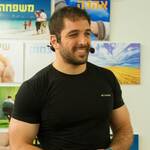PainRelief.com Interview with:
Afik Faerman, PhD
NIMH T32 Postdoctoral Fellow
Psychiatry and Behavioral Sciences
Stanford University
President-elect
Division 30 (Psychological Hypnosis)
American Psychological Association

PainRelief.com: What is the background for this study?
Response: Hypnosis offers an effective drug-free approach to treat a variety of psychophysiological symptoms, particularly pain. Unfortunately, not everyone benefits equally from hypnosis. The ability to experience suggestions in hypnosis (hypnotizability) is distributed in a bell-shaped curve across the population, with only about 20% considered highly hypnotizable. We wanted to test if we could make the brains of people who were not highly hypnotizable act and function as if they were, hoping such a possibility would open the door for improving therapy.
Several brain structures were previously linked to responsiveness to hypnosis, and modulating them could, theoretically, increase hypnotizability. Based on previous work, we created an approach (termed SHIFT) using individual brain scans to find the best part of the brain to stimulate.
PainRelief.com: What are the main findings?
Response: We found that active SHIFT was associated with increased hypnotizability, while sham stimulation did not.
PainRelief.com: What should readers take away from your report?
Response: Even though people differ in their responsiveness to hypnosis, we may be able to use noninvasive technologies to provide more effective, drug-free hypnosis-based treatments for our patients.
PainRelief.com: What recommendations do you have for future research as a result of this study?
Response: This study was designed to answer a mechanistic question – “could it be done?”. Because of that, the stimulation protocol we used was very short – 92 seconds. For reference, the shortest FDA-approved treatment for depression with TMS is 50 stimulation sessions of about 10 minutes each (overall ~500 minutes) across 5 consecutive days (SNT/SAINT). Now that our study has answered the question – it can be done, we are working on our next project to design a clinical stimulation protocol that will explore different approaches to achieve the most clinically applicable intervention.
My vision, as a clinical psychologist, is that in the near future, patients will have a brief stimulation session before their therapy appointment to increase the effectiveness of treatment. This will allow us to, first and foremost, offer effective, drug-free treatments and improve the well-being of our patients, but it will also save time and money for the patients and our healthcare system.
Citation:
Afik Faerman, James H. Bishop, Katy H. Stimpson, Angela Phillips, Merve Gülser, Heer Amin, Romina Nejad, Danielle D. DeSouza, Andrew D. Geoly, Elisa Kallioniemi, Booil Jo, Nolan R. Williams, David Spiegel. Stanford Hypnosis Integrated with Functional Connectivity-targeted Transcranial Stimulation (SHIFT): a preregistered randomized controlled trial. Nature Mental Health, 2024; DOI: 10.1038/s44220-023-00184-z
The information on PainRelief.com is provided for educational purposes only, and is in no way intended to diagnose, cure, or treat any medical or other condition. Always seek the advice of your physician or other qualified health and ask your doctor any questions you may have regarding a medical condition. In addition to all other limitations and disclaimers in this agreement, service provider and its third party providers disclaim any liability or loss in connection with the content provided on this website.
Last Updated on January 5, 2024 by PainRelief.com
